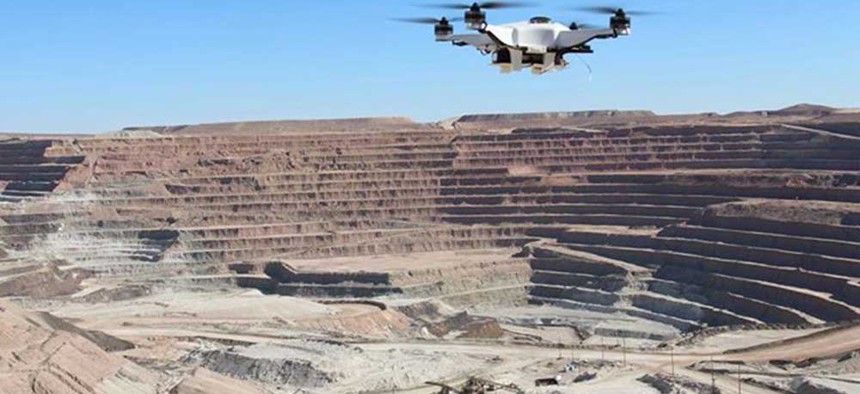
One of Skycatch Inc.'s quadcopter drones in flight. Skycatch
What Drones Can Do Besides Killing Terrorists
It’s time everyone – including the media – start distinguishing between combat drones that kill and surveillance drones that save lives. By Melissa S. Hersh
After reading Patrick Tucker’s provocative article on “Fighting Ebola with Data, Satellites, and Drones,” I’m reminded that semantics do matter. I am decidedly pro-drone. However, making a distinction between intelligence, surveillance, and reconnaissance, or ISR, drones and combat drones is important.
I’m reminded of when I worked for the World Health Organization beginning in the late 1990s on issues related to biological and toxic weapons. Every time we discussed surveillance in the public health setting, everyone nodded their heads and understood the need for continuous monitoring and putting in place early warning systems for detection to aid rapid response and containment measures. When my colleagues and I discussed these issues initially with defense ministries and delegates involved in what later became a failed verification protocol for the Biological and Toxin Weapons Convention, the “S” word – surveillance – was met with resistance. The use of passive and active surveillance is standard operating practice for intelligence and military agencies; concerns over providing conduits for bi-directionally sharing this information with the public health community was anathema to general tradecraft controls over the flow of information.
Surveillance is mutually beneficial for detecting naturally occurring, deliberate and accidental disease outbreaks. Once it was understood that surveillance is a tool employed by the public health community as well as the security sector, our discussions became much easier. Today, enhanced collaboration between military and civilian detection and reporting procedures have been strengthened, in part due to limited successful and attempted uses of biological pathogens as agents of terror.
With drones, while ISR data can contribute to tactical advantages in combat or covert missions, it can also provide situational awareness for humanitarian or non-military strategic planning and interventions. I don’t disagree with the potential use of non-combat drones for providing predictive analytics by proxy – or the use of drones to identify unusual mass gatherings or migrations through the optimization of this imagery and overlaying it with additional data. The latter has been used most recently in the case of Ebola, helping to identify potential outbreak areas.
The use of drones for monitoring infectious disease trends can be seen as both an extension and an expansion of the use of “syndromic surveillance,” which was initially developed for early detection of a large-scale, deliberate release of a biologic agent. Syndromic surveillance is an investigative method used by public health professionals to identify unusual disease clusters or sentinel cases based on electronic reporting. Sometimes syndromic surveillance relies on unconventional and passive sources including surrogate data systems, such as pharmacies reporting increases in purchases around certain symptoms (or prodromes), absenteeism data from work or schools, veterinary and human mortality statistics, and emergency room or clinic visits.
With the Federal Aviation Administration’s anticipated regulations on drones hovering somewhere over the horizon, there is room for increased dialogue on the myriad civil-military uses of drones. As Richard Whittle notes in his new book Predator: The Secret Origins of the Drone Revolution, “Drone technology has already changed the way people die; one day it may change the way people live.” Whittle sagely notes that as UAV technology is here to stay, there is a need for further practical implementation of how to differentiate, regulate and legislate what some view as solely ‘intercontinental sniper rifles’ with the use of UAVs in wildfire management, precision agriculture, commercial distribution, news and entertainment media, and more.
Global Fellow, Woodrow Wilson International Center for Scholars
The current example of the Ebola disaster is not the only instance where non-combat drones can be more than useful, but their application carries different connotations in different contexts. In several weeks, the annual Hajj, the pilgrimage to Mecca, will take place in Saudi Arabia. It is one of the largest mass migrations of religious pilgrims in the world. Despite Saudi Arabian cooperation in the U.S.-led air assault against ISIS in Syria and Iraq, there is serious resistance to permitting sensor-equipped drones to monitor the Hajj from above in advance of and during the forthcoming mass gathering in Mecca.
Concerns about lethal autonomy, indiscriminate use and the potential for backlash over the use of drones in combat or covert operations abound. On the other hand, the U.S. still maintains a significant tactical advantage over foreign states in the realm of ISR technology. How long this advantage will last, however, is not yet known. Americans are caught between a post-NSA backlash and the hope that the ‘baddies’ will be caught by all-seeing, all-listening ISR technologies. Using drones abroad is easy, but people aren’t as keen to see drones darken their own skies; Waziristan but not Wichita, Raqqa but not Raleigh, and Sanaa but not St. Louis.
(Related: Why America Wants Drones That Can Kill Without Humans)
Civil-military ISR drones need to be distinguished from combat drones. Moreover, it is the responsibility of the news media, scientists, technologists and innovators to speak about UAVs or drones responsibly by clarifying the difference between surveillance and combat drones. Dramatic discussions of the possibility of introducing lethal vehicles in the form of nano-kamikazes or nano-martyrs is not just the realm of science fiction. Discussions of that sort, however, avoid the real challenge, which is how to manage the proliferation of aerial, terrestrial, underwater and space drones to get the most out of the technology while keeping it under control.




